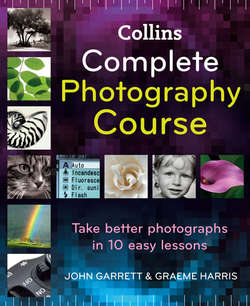Читать книгу Collins Complete Photography Course - John Garrett, Graeme Harris - Страница 22
Digital quality
ОглавлениеDigital cameras use three different file formats to store the images on the memory card: JPEG, TIFF and RAW.
The file format that you choose has a big influence on the final quality of your pictures and also on the amount of pictures you can store on the memory card.
JPEG format
This type of file is processed by the camera’s computer, which applies all the settings that you have selected, such as colour balance, contrast and sharpening, to form the digital image. It then compresses the image to the file size and quality (fine, normal or basic) you have chosen.
Although the large size and fine setting takes up more space on the memory card, it’s best to select it because you may want to do a bigger print in the future. Even if you think you are only aiming for postcard-size prints, there may be some shots you are so pleased with that you want to print them poster-size, and if you have used a smaller file size you have ruled out that option.
Fine (less compressed) JPEG files produce high-quality images and are used by many professional photographers.
RAW format
If you save your file in RAW format, you are storing all the image information that is received by the camera. It’s the digital equivalent of the analogue camera’s negative. Every detail is in the file for the photographer to download onto the computer and make adjustments to later; just like the film photographer will take his or her negative into the darkroom and use the information on it to make a print, so the digital photographer will open up a RAW file in Photoshop and process the image to make a final interpretation. This is then saved as a separate file, and the RAW file is kept untouched ready for future use.
The disadvantages of RAW files are that because they are not compressed by the camera they take up more space on the memory card, and the camera also has to pause more frequently to write them to the card. While professional cameras can do this fast enough not to cause a problem, keeping up with the action at a sports event, for example, isn’t practicable with many consumer-level cameras.
The CD provided with your camera should include software to enable you to process the RAW files. If not, you may have to buy a program or download a free one.
Some cameras have the facility to shoot RAW and JPEG at the same time. Many professionals use the JPEGs as a digital equivalent of a darkroom contact sheet from which to choose the best pictures then get to work on the RAW images.
TIFF format
In terms of quality, TIFF files lie between JPEG and RAW files. They are compressed, but not as much as JPEGs; they lose no detail, but take up much more space than a JPEG, though less than a RAW file.
You have a choice of file formats. Shooting high image quality and large file size will allow you to do large prints if you ever need them. Use RAW if you plan to do extensive retouching on your pictures in Photoshop.
So, your choice of file type depends on how many pictures you want to get on the card and on the quality you are after. However, not all cameras offer TIFF as an option for storage.
Memory cards
In the digital camera, the memory card replaces the function of film in terms of recording the images. The cards are available in different memory capacities; which you decide to buy will depend on the number of images you want them to hold, and their size. They also have different transfer speeds – the faster they record, the faster you can shoot.
Make sure you turn your camera off before you insert or remove a card. Before you use a card for the first time, you must format it in the camera. Reformatting a card which contains images will permanently erase them, so make sure you have copied them first.
It’s a good idea to have several smaller capacity cards instead of one large one, especially when you go on holidays. That eliminates the possibility of losing all your pictures if you damage or lose a card.
Downloading
There are different ways of downloading the pictures from your memory card. You can download directly from your camera to your computer using the USB cable supplied, but it’s quicker to download via a separate card reader. As a precaution, many photographers download their images onto a portable storage device or laptop computer while on location. Some printers have card readers built in and you can print directly from your card without needing a computer.
